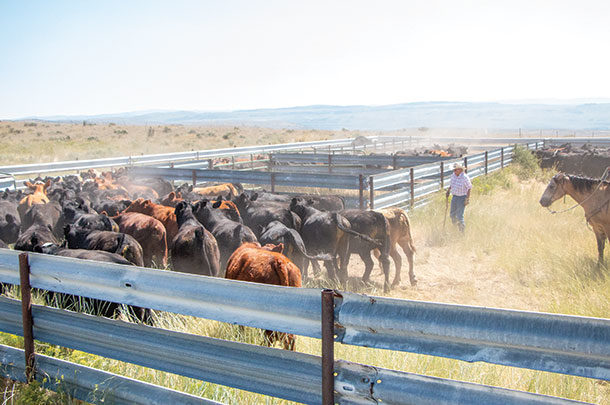Editor’s note: This is the final article in a three-part series. Stocker cattle operators have been described as the cattle industry’s shock absorber between cow-calf producers and feedlot managers.
Calves typically move from ranches to grazing pastures, then on to feedlots for finishing. Coupled to this flow of calves is the burden that approximately 75% of the calves produced in this country are weaned in the fall of the year. This abundance of calves is placed in feedlots throughout the year because stocker cattle operators respond to market signals by slowing the movement or speeding up the movement by grazing these calves on pastures. Stocker operators must be flexible due to these changing market conditions, weather conditions that influence the volume of grass available and varying performance of the cattle.
Calculating the profitability of these cattle and determining what financial indicators influence those profits is paramount. In this final article, we explore the financial data needed and how to generate the financial results and key indicators.
Listed below are six pieces of financial data needed to determine stocker cattle profits. While these seem obvious, at times incorrect or incomplete data is used, yielding results that are skewed or inaccurate. Also, the financial data is typically used in total by accountants at the end of the year while, throughout the grazing period, much of the data is quoted on a per-head or per-pound basis by the stocker cattle operator. Here is the financial data.
- Total revenue and revenue per head are the dollars received from the sale of the stocker cattle. Very simply, the total revenue is price times weight times head. Yet, more specifically, price is defined as the payweight price where the quoted price is reduced by shrink adjustments, commissions and fees. Weight is a shrunk weight of the cattle referred to as payweight, and the number of head is the number sold. Death loss is an important and manageable metric that impacts the number sold. Revenue per head, then, is payweight price times payweight of calves sold.
- Cattle cost and cost per head are the total expense for the stocker cattle delivered to the operator. Countless articles have discussed the merits of buying particular types of cattle, cattle that have been conditioned, undervalued cattle, etc. For purchased cattle, this is obvious. But what about raised cattle that are retained and grazed to an older age and heavier weight? In this case, the most accurate cost per calf is the accumulated cost of the calf weaned on the ranch. In determining stocker cattle profitability, it is common, but inaccurate, to use a market value for that calf, especially if market value is lower than the accumulated cost.
- Gross margin and gross margin per head are the difference between the total revenue (per head) and the cattle cost (per head). On a per-head basis, this is the dollar amount that can be spent to gain the calf from the purchased weight to the payweight weight. The stocker cattle segment is a margin business, margin being the difference between the sold value per head and the purchased value per head. While calf prices have ranged from high to low, this margin is relatively predictable over time. However, this margin is a good indicator of stocker operators’ skills of buying and selling cattle. A wide margin is preferred and is indicative of cattle either being purchased below market value or sold above market value.
- Direct expenses and direct expenses per head are those expenses directly attributable to the cattle. These would include purchased feed, pasture costs, animal health, freight, interest and others. These are obvious and somewhat predictable expenses, but profitability requires the total be less than the gross margin per head.
- Indirect expenses and indirect expenses per head are expenses some stocker cattle operators do not account for. These would include operator labor and management costs, and vehicle and machinery costs such as repairs, fuel and depreciation. These expenses are not so obvious and may even be shared with other enterprises. If an operator has reviewed previous-year operational expenses, indirect cost should be somewhat predictable.
- Finally, total expenses (or total expenses per head) are simply the sum of the cattle costs, direct and indirect expenses. This is expressed in total or on a per-head basis.
Whether the stocker cattle made a profit or loss, savvy stocker cattle operators are compelled to evaluate each group individually. The financial results and key performance indicators start with the net income of the group and net income per head. The stocker cattle are profitable if total revenue is greater than total expenses or the gross margin is higher than the sum of the direct and indirect expenses.
As with other cattle enterprises, the unit cost of production (UCOP) is a valuable indicator of performance. Two UCOPs are common with stocker cattle: UCOP per head and UCOP per hundredweight (cwt) sold. While the former is less utilized, the latter can be compared with the payweight price to determine the marketing margin per cwt. In the previous two articles, we emphasized that the difference between UCOP per cwt and the break-even price was that breakeven considered any secondary revenue. Stocker enterprises rarely experience secondary revenue. Consequently, for most stocker cattle, UCOP per cwt and break-even price are the same.
Another key performance indicator for stocker cattle is the cost per pound of gain. This cost is calculated as ([direct expenses + indirect expenses] / total pounds gained). Cost of gain and likelihood of profitability are inversely related. Fewer expenses and superior cattle performance (weight gain) influence this indicator positively.
These results and indicators are not an exhaustive list. Things like death loss, underperforming cattle, unforeseen market swings, marketing alternatives such as futures or options, unexpected changes in forage quantity or quality, as well as others influence stocker cattle profitability. Successful stocker cattle operators carefully evaluate each turn of cattle and use production and financial experience to accurately project stocker cattle profitability prior to purchases. Accurately predicting and managing unit cost of production is key to sustainably providing the inventory “shock absorption” ranchers and cattle feeders depend on.
This article is part one of a three-part series. Be sure to read part one, “Bragging rights require knowing costs,” and part two, “Unit cost of production expressions.”








